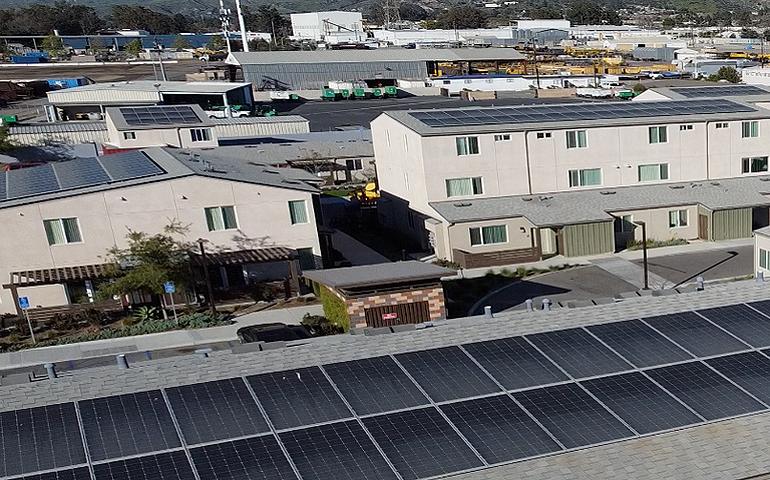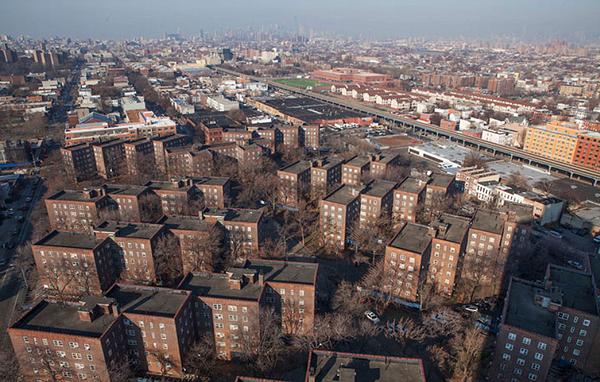Biden Invests Billions in Efficient Energy for Public Buildings

WASHINGTON, DC, May 18, 2023 (Maximpact.com Sustainability News) – These days President Joe Biden says, “I’m not joking, folks,” a lot. With all his friendly kidding around, the U.S. President is serious about many things, and supplying buildings in American cities with cleaner energy, particularly federal government buildings, is close to the top of his list.
As part of President Biden’s Investing in America agenda, last week the U.S. Department of Housing and Urban Development (HUD) funded incorporated climate risk and mitigation into federally-supported housing.
HUD released a more than US$830 million funding notice for the Green and Resilient Retrofit Program (GRRP) and announced $4 billion in loan commitment authority for this new program.
The GRRP provides funding for direct loans and grants to fund projects that improve energy or water efficiency, enhance indoor air quality or sustainability, implement the use of zero-emission electricity generation, low-emission building materials or processes, energy storage, or building electrification strategies, or address climate resilience, of eligible HUD-assisted multifamily properties.
HUD expects to make approximately 200 awards with $140 million in funding for installation of electric HVAC heat pumps, Energy Star windows, fire resistant roofs and clean energy generation
systems.
HUD expects to make approximately 100 awards with $400 million in funding for ambitious retrofit activities to achieve an advanced green certification under
And HUD expects to make approximately 300 awards with $1.47 billion in funding fo comprehensive awards provide funding to properties with the highest need for climate resilience and utility efficiency upgrades, regardless of prior development or environmental retrofit experience.
The Inflation Reduction Act, which funds the GRRP, also includes $42.5 million for a new HUD initiative launching this summer to collect and assess energy and water usage data from multifamily housing properties that receive federal financial assistance.
The GRRP is the largest HUD program to date that directly invests in energy efficiency and emissions reductions, clean energy, and climate resilience strategies across HUD-assisted multifamily housing.

President Biden has charged the federal government to lead by example by sustainably managing its footprint of over 300,000 buildings, over 600,000 vehicles, and $650 billion spent annually on goods and services.
Late in 2021, his first year in office, Biden issued his Federal Sustainability Plan, which directs the federal government to achieve net zero emissions operations by 2050. This is to be accomplished by transitioning federal infrastructure to zero-emission vehicles and energy efficient buildings, powered by carbon free electricity.
Work to achieve this plan is already underway. U.S. General Services Administrator Robin Carnahan toured the Earle Cabell Federal Building and Courthouse in Dallas last week and announced $43.5 million for improvements at 10 federal buildings as part of the Biden agenda.
Two of the buildings – Cabell and the New Orleans Custom House – will undergo “deep energy retrofits,” meaning at least a 40 percent reduction in emissions. At Cabell, one of the largest consumers of energy among federal buildings in the region, the project will reduce energy consumption by an estimated 49 percent, supported by magnetic levitation chillers, building automation improvements, and high-efficiency transformers.
Examples of other major upgrades in the 10 buildings include chiller replacements with cleaner refrigerants at the Terminal Annex Federal Building in Dallas and the Hale Boggs Federal Building and Courthouse in New Orleans.
Through an Energy Savings Performance Contract, GSA will upgrade building infrastructure and install new technologies that will reduce energy consumption and costs at four federal buildings in the Dallas area and six in Louisiana. The investments are estimated to save about $1.4 million per year at today’s energy prices and reduce emissions by about 6,000 metric tons per year.
The contract was awarded to Ameresco, based in Massachusetts. “It is an honor to have been selected to work on this critical project with GSA. It will improve facility infrastructure and ensure energy needs are met at federal buildings across two states while furthering the Administration’s 2045 goal,” said Nicole Bulgarino, executive vice president at Ameresco, an independent clean technology integrator of comprehensive services, energy efficiency, infrastructure upgrades, asset sustainability and renewable energy solutions for businesses and organizations in North America and Europe.
“Partnerships such as this further demonstrate the leadership and progress of the federal government to strengthen and encourage the clean energy transition,” Bulgarino said.
This project is one of many supported by the Inflation Reduction Act – which provided $3.4 billion to GSA for emerging and sustainable technologies, low-embodied carbon materials, and other measures to improve the sustainability of the federal footprint.
These efforts will help achieve the administration’s goal of a net-zero emissions buildings portfolio by 2045.
“These investments are a prime example of how President Biden’s Investing in America agenda is a triple-win: we’re creating good jobs, saving taxpayer dollars through energy efficiency, and ensuring a healthier, brighter future for our communities and our kids,” said GSA Administrator Robin Carnahan. “We look forward to working with industry and other stakeholders as we maximize the impact of these investments for the benefit of communities in Texas and Louisiana.”
Families Save on Energy Costs
HUD, the Federal Housing Administration, and the U.S. Department of Agriculture propose to adopt the latest energy codes to improve the performance and efficiency of new homes, and help homeowners and renters save money.
HUD estimates that families will save over 35 percent on energy costs by building homes using the latest energy codes. The administration will give communities the tools to build and retrofit safe, resilient, healthy, and efficient buildings that are powered by clean energy and constructed with low-carbon materials.
Energy efficiency, electrification, and clean energy will make energy costs a smaller fraction of household expenses, insulating hard-working families and underserved communities from volatile energy prices, the White House said in a statement.
This builds on President Biden’s National Initiative to Advance Building Codes, which supports modern building codes and standards that save lives, reduce property damage, and cut utility bills.
In support of the Federal Buy Clean Initiative, HUD will now prioritize the use of building materials with lower embodied carbon for retrofits and new construction. These efforts will help scale up demand for American-made building materials that have less climate impact associated with mining, manufacturing, and transportation.
The nonprofit Rocky Mountain Institute in Colorado, which aims to improve America’s energy practices, delves into the new subject of embodied carbon in a March post by Madeline Weir, Audrey Rempher, and Rebecca Esau.
“Embodied carbon represents the millions of tons of carbon emissions released during the lifecycle of building materials, including extraction, manufacturing, transport, construction, and disposal,” the three authors write. “Concrete, steel, and insulation are all examples of materials that contribute to embodied carbon emissions.”
“Because they account for 11 percent of global greenhouse gas (GHG) emissions, it is imperative for builders, manufacturers, and policymakers to prioritize this issue to meet climate goals.”
“Reducing embodied carbon has emerged as a vital new frontier in building decarbonization and is rapidly gaining global recognition among leaders in architecture and design, manufacturing, and construction,” write Weir, Rempher and Esau.
Solar Becomes More Affordable
Building upon the national guidance last summer, HUD is helping families to subscribe to local community solar. With new guidance for how residents of master-metered HUD-assisted housing can benefit from solar, HUD aims to set the stage for 4.5 million families to reap the benefits of community solar which, on average, can save families 10 percent a year on their electric bills.
In April, Vice President Kamala Harris visited Dalton, Georgia, where she unveiled the largest community solar project in U.S. history, enough to power 140,000 homes and businesses in three states.
Vice President Harris announced the deal during a visit to the Qcells solar panel factory. The South Korean company’s corporate parent, Hanwha Solutions Corp., said in January it will invest US$2.5 billion to expand its Dalton plant and build another plant in nearby Cartersville, Georgia.
Qcells projects it will supply about 30 percent of total U.S. solar panel demand by 2027, including making solar panel components usually manufactured outside the United States.
A deal announced by Harris calls for Qcells and Virginia-based Summit Ridge Energy to deploy community solar projects capable of generating 1.2 gigawatts of electricity in Illinois, Maine and Maryland.
Community solar projects allow people to tap into solar power generated at a shared site rather than on individual rooftops and are a way for renters and those without access to rooftop solar panels to receive the benefits of clean energy.
In her speech at the Qcells plant, Harris said. “Since taking office, our administration has made the largest investment in solar energy in our nation’s history. We strengthened domestic supply chains to make sure America has reliable access to parts and materials to build a clean energy technology and economy. We provided tax credits to encourage companies to buy solar panels made in America. And we invested billions more to build and expand factories like this one.”
Finally, HUD has issued a new Policy Development and Research Disaster Recovery Tool Kit, “Designing for Natural Hazards: A Resilience guide for Builders and Developers,” which was provided to building and developers seeking to incorporate climate resilience in housing.